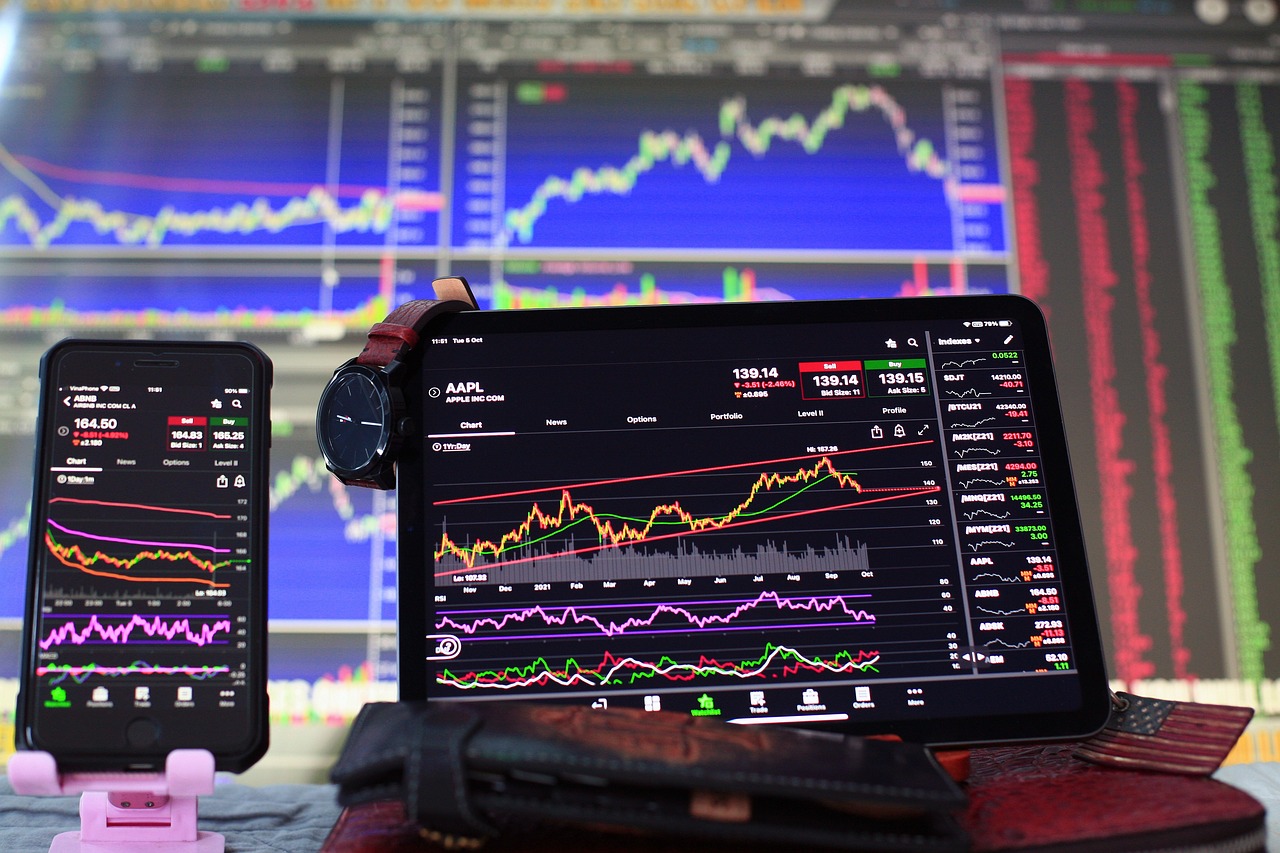Understanding Risk-Reward Ratios in Trading
Trading can often feel like navigating a stormy sea, where the waves of uncertainty can either lift you to new heights or capsize your portfolio. One of the most vital tools in a trader's arsenal is the risk-reward ratio. This concept is not just a number; it's a guiding principle that helps traders make informed decisions, manage their investments wisely, and set realistic expectations for profit and loss.
But what exactly is a risk-reward ratio? In simple terms, it compares the potential profit of a trade to the potential loss. Think of it as a balancing scale: on one side, you have the risk (the amount of money you could lose), and on the other, the reward (the potential profit you could gain). A well-calibrated risk-reward ratio can be the difference between success and failure in trading.
Understanding why these ratios are crucial can significantly impact your trading journey. For starters, they help you to quantify your trades, allowing you to make decisions based on data rather than emotion. This is essential because trading is often fraught with psychological challenges. By focusing on risk-reward ratios, traders can mitigate the influence of fear and greed, which are notorious for clouding judgment.
Moreover, a solid grasp of risk-reward ratios empowers traders to develop effective trading strategies. When you know the potential risk associated with a trade, you can adjust your position size accordingly. This means that even if you encounter a losing streak, your overall capital is better protected. In essence, understanding risk-reward ratios is like having a life vest while sailing—you may still face rough waters, but you’re far less likely to sink.
Now, let’s dive deeper into the mechanics of calculating risk-reward ratios. The formula is straightforward:
| Risk | Reward | Risk-Reward Ratio |
|---|---|---|
| $100 | $300 | 1:3 |
| $50 | $150 | 1:3 |
In the table above, you can see how different trades yield the same risk-reward ratio. The key takeaway is that a favorable risk-reward ratio (ideally 1:3 or higher) means that for every dollar you risk, you stand to gain three. This not only enhances your profitability but also provides a buffer against inevitable losses.
In conclusion, understanding risk-reward ratios is paramount for any trader looking to navigate the complexities of the market. By embracing this concept, you can transform your approach to trading from one of uncertainty to one of calculated risk. So, the next time you consider a trade, ask yourself: What is my risk-reward ratio? This simple question could change the way you trade forever.
- What is a good risk-reward ratio? A ratio of 1:3 is generally considered good, meaning you aim to make three times what you are willing to lose.
- How do I apply risk-reward ratios in my trading strategy? Calculate your potential loss and potential gain before entering a trade, and adjust your position size accordingly.
- Can I have a low risk-reward ratio and still be profitable? Yes, but it requires a high win rate. Most traders prefer higher ratios for added safety.

The Importance of Risk-Reward Ratios
Understanding why risk-reward ratios are crucial in trading can help traders manage their investments wisely and set realistic expectations for profit and loss. In the world of trading, every decision carries a certain level of risk, and knowing how to balance that risk with potential rewards is what separates successful traders from the rest. Think of it like walking a tightrope; without a clear understanding of the balance between risk and reward, you might find yourself tumbling into the abyss of losses.
At its core, the risk-reward ratio is a simple concept: it compares the potential profit of a trade to the potential loss. For example, if you're considering a trade that could yield a profit of $300 but has a risk of $100, your risk-reward ratio is 1:3. This means for every dollar you risk, you stand to gain three. Understanding this ratio allows traders to make more informed decisions, leading to better outcomes over time.
The importance of risk-reward ratios extends beyond just individual trades. They play a vital role in shaping your overall trading strategy. By consistently applying this principle, traders can:
- Manage Risk Effectively: Knowing your risk-reward ratio helps you to determine how much of your capital to risk on any single trade.
- Set Realistic Goals: With a solid understanding of potential outcomes, traders can set achievable profit targets that align with their risk tolerance.
- Avoid Emotional Decisions: Having a clear risk-reward framework can reduce the emotional rollercoaster that often accompanies trading.
Additionally, understanding risk-reward ratios can help traders identify high-probability setups. When a trade offers a favorable risk-reward ratio, it’s often a signal that the market conditions are right for entering a position. This not only boosts the trader's confidence but also enhances their ability to stick to their trading plan, even when the market gets choppy.
In summary, mastering the concept of risk-reward ratios is not just a nice-to-have skill; it's an essential part of being a successful trader. By keeping these ratios in mind, traders can navigate the often turbulent waters of the financial markets with greater ease and confidence. This understanding can lead to improved decision-making and ultimately, increased profitability. So, the next time you consider a trade, remember to ask yourself: is the potential reward worth the risk?

Calculating Risk-Reward Ratios
Calculating the risk-reward ratio is a fundamental skill every trader should master. This ratio helps traders assess the potential return of an investment relative to its risk. To put it simply, it’s like weighing the pros and cons before making a decision. Imagine you’re at a carnival, and you see a game that costs $10 to play. If you win, you get a plush toy worth $50. In this scenario, your risk is $10, and your reward is $50. Thus, your risk-reward ratio would be 1:5. This means for every dollar you risk, you stand to gain five dollars.
The formula for calculating the risk-reward ratio is straightforward:
Risk-Reward Ratio Potential Loss / Potential Gain
Let’s break this down with an example. Suppose you’re considering buying a stock priced at $100. You set a stop-loss order at $95 to limit your loss, which means your potential loss is $5. If you aim to sell the stock at $110, your potential gain is $10. Plugging these numbers into the formula gives:
Risk-Reward Ratio $5 / $10 1:2
This ratio indicates that for every dollar you risk, you could potentially make two dollars. The higher the ratio, the more attractive the trade becomes. A ratio of 1:3 or higher is often considered ideal, as it suggests that the potential reward significantly outweighs the risk.
However, it’s essential to remember that risk-reward ratios are not the only factor to consider. Market conditions, volatility, and your trading strategy all play a crucial role. Therefore, it’s advisable to regularly evaluate your risk-reward ratios and adjust your trading plans accordingly.
To help visualize this, here’s a simple table:
| Trade Example | Potential Loss | Potential Gain | Risk-Reward Ratio |
|---|---|---|---|
| Stock A | $5 | $10 | 1:2 |
| Stock B | $3 | $9 | 1:3 |
| Stock C | $10 | $20 | 1:2 |
As you can see from the table, Stock B offers the best risk-reward ratio, making it a more favorable option for traders looking to maximize their returns. It’s crucial to incorporate this analysis into your trading strategy to make informed decisions.
In conclusion, understanding and calculating risk-reward ratios is vital for any trader aiming to improve their profitability. It not only helps in making sound decisions but also instills a disciplined approach to trading. So, the next time you’re analyzing a trade, remember to calculate your risk-reward ratio and let it guide your strategy!

Setting Entry and Exit Points
When it comes to trading, determining the right entry and exit points can feel like trying to hit a moving target in a game of darts. You want to land your trades with precision, maximizing your potential profits while keeping your losses in check. This is where the concept of risk-reward ratios becomes invaluable. By carefully analyzing and setting your entry and exit points based on these ratios, you can create a robust trading strategy that not only enhances your decision-making but also boosts your confidence in the market.
First, let’s break down what an entry point is. An entry point is the price level at which you decide to buy or sell an asset. Ideally, you want to enter a trade when the price is favorable, setting yourself up for a profitable outcome. To identify this point, consider using technical indicators such as moving averages, support and resistance levels, or even trend lines. These tools can help you pinpoint the most advantageous entry points based on historical price movements.
Now, let’s talk about exit points. An exit point is crucial because it dictates when you will close your position, whether it’s to lock in profits or cut losses. Setting exit points can be done through two primary methods: profit targets and stop-loss orders. Profit targets are predetermined prices where you plan to take your gains, while stop-loss orders are designed to minimize your losses by closing your position when the asset reaches a specified price.
To effectively set these points, you need to calculate your risk-reward ratio. Here’s a simple formula to help you:
| Risk-Reward Ratio | Formula |
|---|---|
| Risk | Entry Price - Stop-Loss Price |
| Reward | Profit Target Price - Entry Price |
| Risk-Reward Ratio | Risk / Reward |
For example, let’s say you enter a trade at $50, set a stop-loss at $48 (risking $2), and establish a profit target at $56 (potential reward of $6). Your risk-reward ratio would be:
Risk-Reward Ratio $2 (Risk) / $6 (Reward) 1:3
This means for every dollar you risk, you stand to gain three dollars. A ratio of 1:3 is generally considered favorable, as it indicates that your potential reward outweighs your risk.
Another essential aspect of setting entry and exit points is being adaptable. Market conditions can change rapidly, and what might have been a good entry or exit point yesterday may not hold true today. Keeping an eye on market news, economic reports, and global events can help you adjust your strategy. Regularly reviewing and tweaking your risk-reward ratios based on current market trends can lead to more successful trades.
In conclusion, setting effective entry and exit points is a blend of art and science. By leveraging risk-reward ratios, utilizing technical analysis, and being adaptable to market changes, you can create a powerful trading strategy. Remember, the goal is to make informed decisions that enhance your trading experience and profitability.
- What is a good risk-reward ratio for trading? A ratio of 1:2 or 1:3 is often recommended, meaning for every dollar risked, you should aim to gain two or three dollars.
- How do I adjust my entry and exit points? Monitor market conditions, utilize technical indicators, and be prepared to adapt your strategy based on new information.
- Can I use risk-reward ratios in all trading styles? Yes, risk-reward ratios can be applied to various trading styles, including day trading, swing trading, and long-term investing.

Using Stop-Loss Orders
When it comes to trading, the implementation of stop-loss orders is not just a smart move; it’s a necessity. Think of a stop-loss order as your safety net in the unpredictable circus of the trading world. Just like a tightrope walker wouldn’t dare to perform without a safety net below, traders should never venture into the market without a stop-loss in place. This tool helps you manage risk effectively, ensuring that you don’t lose more than you can afford to. But how do you set it up? Let’s dive into the details!
To begin with, a stop-loss order acts as a preset instruction to sell a security when it reaches a certain price. This means you can limit your losses without having to constantly monitor the market. Imagine you’ve bought shares at $100, and you set a stop-loss order at $90. If the price drops to $90, your shares will automatically be sold, preventing further losses. This way, you’re not just hoping for the best; you’re taking proactive steps to protect your investment.
Now, the question arises: how do you determine the right level for your stop-loss? It’s essential to consider your risk-reward ratio here. A common approach is to set the stop-loss at a percentage below your entry price. For instance, if you’re aiming for a 2:1 risk-reward ratio, and you’re targeting a profit of $20, you might set your stop-loss at $10 below your entry price. This keeps your losses manageable while allowing for potential gains.
Here’s a simple table to illustrate how stop-loss orders work in conjunction with risk-reward ratios:
| Entry Price | Target Price | Stop-Loss Price | Risk-Reward Ratio |
|---|---|---|---|
| $100 | $120 | $90 | 2:1 |
| $150 | $180 | $140 | 2:1 |
In addition to setting the stop-loss based on your risk-reward ratio, it’s crucial to consider market conditions. For example, if you’re trading during a period of high volatility, you might want to set your stop-loss a bit further away from your entry point to avoid getting stopped out prematurely. However, be cautious—setting it too far can expose you to larger losses than you initially intended. It’s a balancing act that requires careful thought and analysis.
Another vital aspect to keep in mind is the use of trailing stop-loss orders. These orders move with the market price, allowing you to lock in profits as the price increases while still protecting against losses. For instance, if you set a trailing stop-loss at $5 below the current market price, and the price rises to $110, your stop-loss will automatically adjust to $105. This feature can be a game-changer, especially in trending markets.
In conclusion, using stop-loss orders is a fundamental component of a solid trading strategy. They not only help you manage risk but also provide peace of mind, allowing you to focus on making informed trading decisions rather than constantly worrying about potential losses. Remember, the market can be unpredictable, but with the right tools in your trading toolbox, you can navigate it with confidence.
- What is a stop-loss order? A stop-loss order is an instruction to sell a security when it reaches a specific price, helping to limit potential losses.
- How do I determine where to set my stop-loss? Consider your risk tolerance and the risk-reward ratio you’re aiming for when setting your stop-loss level.
- What is a trailing stop-loss? A trailing stop-loss is a type of stop-loss that moves with the market price, allowing you to lock in profits while still protecting against losses.
- Can stop-loss orders guarantee that I won't lose money? While stop-loss orders help manage risk, they cannot guarantee against losses, especially in fast-moving markets.

Adjusting Targets Based on Market Conditions
In the ever-changing landscape of trading, adjusting your targets based on market conditions is not just a good practice—it's a necessity. Imagine sailing a boat; if the winds shift, you wouldn't keep your sails set the same way, right? Similarly, traders need to remain flexible and responsive to market dynamics. By doing so, you can enhance your chances of achieving your profit goals while effectively managing risk.
Market conditions can fluctuate due to various factors, including economic indicators, geopolitical events, and even market sentiment. For instance, during a bullish market, traders might set higher profit targets because the upward momentum suggests that prices will continue to rise. Conversely, in a bearish market, it may be prudent to lower your targets to ensure that you can still lock in profits before prices potentially decline further.
One effective way to adjust your targets is by regularly analyzing market trends and indicators. Utilizing tools like moving averages, Relative Strength Index (RSI), or Bollinger Bands can provide insights into whether the market is in an upward or downward trend. For example, if your analysis shows that the market is overbought, it may be wise to adjust your profit target downward to account for a potential price correction.
Another crucial aspect of adjusting targets is the timeframe of your trades. Short-term traders may need to adjust their targets more frequently than long-term investors due to the increased volatility they face. Here’s a quick breakdown:
| Trading Style | Adjustment Frequency |
|---|---|
| Day Trading | Multiple times a day |
| Swing Trading | Daily to weekly |
| Position Trading | Weekly to monthly |
Moreover, it’s essential to maintain a balance between ambition and realism. Setting targets that are too ambitious might lead to disappointment and emotional trading decisions, while overly conservative targets could mean missing out on potential profits. Therefore, a good practice is to set tiered targets. For instance, you might have a primary target based on your initial analysis and a secondary target that allows for a little more upside if the market conditions remain favorable.
In conclusion, adjusting your targets based on market conditions is a vital component of a successful trading strategy. By staying informed and flexible, you can navigate the unpredictable waters of trading more effectively. Remember, the key lies in being proactive rather than reactive, ensuring that your targets align with the current market environment.
- What is a risk-reward ratio? A risk-reward ratio is a calculation used by traders to assess the potential profit of a trade relative to its potential loss.
- How do I calculate my risk-reward ratio? You can calculate it by dividing the amount you expect to gain by the amount you are willing to risk. For example, if you aim to gain $300 and are willing to risk $100, your risk-reward ratio is 3:1.
- Why are risk-reward ratios important? They help traders make informed decisions, manage their investments wisely, and set realistic expectations for profit and loss.
- How can I adjust my targets effectively? Regularly analyze market trends and indicators, consider your trading style, and maintain a balance between ambition and realism when setting targets.

Common Mistakes in Risk-Reward Assessment
When it comes to trading, understanding risk-reward ratios is crucial, but many traders often stumble over common pitfalls that can derail their strategies. One significant mistake is not properly calculating the risk-reward ratio before entering a trade. Imagine you're about to dive into a swimming pool without checking the depth first; it could lead to a painful surprise! Similarly, failing to assess your risk can lead to unexpected losses that could have been avoided.
Another frequent error is setting unrealistic expectations. Traders often dream of hitting the jackpot with every trade, leading them to set overly ambitious profit targets. While it's great to be optimistic, it’s vital to maintain a balance. Aiming for a reward that is significantly disproportionate to the risk taken is like trying to catch a big fish with a flimsy line—you're just setting yourself up for disappointment.
Moreover, many traders neglect to adjust their risk-reward ratios based on market conditions. The market is a living entity, constantly shifting and changing. Sticking to rigid targets without considering the current market landscape is akin to sailing a ship without adjusting your sails to the wind. This oversight can result in missed opportunities or, worse, significant losses.
It’s also common for traders to ignore the importance of stop-loss orders. This tool is essential for managing risk effectively. When traders fail to implement stop-losses, they expose themselves to unnecessary risk. Think of stop-loss orders as a safety net; without it, you’re juggling on a tightrope without any safety harness.
Lastly, many traders fall into the trap of emotional trading, allowing fear and greed to dictate their actions. This emotional rollercoaster can lead to impulsive decisions that contradict their calculated risk-reward ratios. To combat this, it's vital to stay disciplined and stick to your trading plan. Remember, trading is a marathon, not a sprint!
In summary, avoiding these common mistakes can significantly enhance your trading performance. By properly calculating your risk-reward ratios, setting realistic expectations, adjusting your targets based on market conditions, implementing stop-loss orders, and maintaining emotional discipline, you'll be well on your way to becoming a more successful trader.
- What is a good risk-reward ratio? A common rule of thumb is a risk-reward ratio of 1:2 or higher, meaning for every dollar risked, the potential reward should be at least two dollars.
- How often should I reassess my risk-reward ratios? It's wise to reassess your ratios with every new trade or when significant market changes occur.
- Can I use risk-reward ratios in all trading strategies? Yes, risk-reward ratios can be applied across various trading strategies, including day trading, swing trading, and long-term investing.

Psychological Aspects of Risk-Reward Ratios
When it comes to trading, the psychological aspects of risk-reward ratios can’t be overlooked. Trading is not just about numbers and charts; it’s also a game of the mind. Every decision you make is influenced by your emotions, and understanding how these emotions interact with risk-reward ratios can significantly impact your trading success. Have you ever felt that rush of excitement when you see potential profits, only to be gripped by fear when the market turns? This emotional rollercoaster is something every trader experiences, and it’s crucial to learn how to navigate it.
One of the biggest challenges traders face is the duality of fear and greed. Fear can lead to missed opportunities, while greed can push you to take unnecessary risks. For instance, when you set a risk-reward ratio of 1:3, you’re essentially saying that for every dollar you risk, you aim to make three. But if the market starts moving against you, fear can kick in, making you second-guess your strategy. You might panic and exit the trade too early, potentially leaving profits on the table. Conversely, if you’re too greedy, you may ignore the risk altogether, hoping for that big win, which can lead to devastating losses.
To combat these emotional pitfalls, it’s essential to develop a disciplined approach to trading. This is where understanding risk-reward ratios comes into play. By having a clear plan and sticking to it, you can create a sense of confidence in your trading decisions. It’s like having a roadmap for a long journey; knowing your destination and the steps to get there helps alleviate anxiety. When you understand how to calculate and apply risk-reward ratios, you can make more informed decisions that align with your trading goals.
Another psychological factor to consider is how market conditions can influence your perception of risk and reward. During volatile periods, traders may feel compelled to adjust their risk-reward ratios, often in reaction to fear of loss or the lure of quick profits. This can lead to inconsistency in trading strategies. Therefore, it’s vital to maintain a balanced perspective and adjust your approach based on well-thought-out criteria rather than emotional responses.
In summary, the psychological aspects of risk-reward ratios are just as critical as the mathematical calculations. By recognizing the influence of emotions like fear and greed, and by developing a disciplined trading mindset, you can improve your decision-making process. Remember, trading isn’t just about the numbers; it’s about understanding yourself and how you react to the ever-changing market landscape.
- What is a risk-reward ratio?
A risk-reward ratio is a measure used by traders to assess the potential profit of a trade relative to its potential loss. It helps in making informed trading decisions. - How can I overcome fear in trading?
To overcome fear, focus on creating a solid trading plan, use risk management techniques, and practice trading discipline to stick to your strategy. - Is it possible to be too greedy in trading?
Yes, excessive greed can lead to taking unnecessary risks and ignoring your risk management rules, which can ultimately result in significant losses.

Overcoming Fear and Greed
In the world of trading, fear and greed are like two sides of the same coin, constantly battling for control over your decisions. Have you ever found yourself hesitating to make a move because you were afraid of losing money? Or perhaps you jumped into a trade because you were overly excited about potential profits? These emotions can cloud your judgment and lead to poor decision-making, which is why learning to overcome them is crucial for any trader.
First, it’s essential to recognize that fear and greed are natural human emotions. They are deeply rooted in our psyche and can often manifest in trading scenarios. Fear might make you sell too early, while greed can push you to hold onto a losing position longer than necessary. To combat these feelings, one effective strategy is to establish a trading plan that includes clear risk-reward ratios. This plan acts as a roadmap, guiding your decisions and helping you stay focused on your long-term goals rather than getting swept away by fleeting emotions.
Another powerful technique is to practice mindfulness. By becoming more aware of your thoughts and feelings while trading, you can better manage your reactions. For example, when you feel fear creeping in, take a moment to breathe deeply and assess the situation objectively. Ask yourself questions like: “Is this fear based on facts or assumptions?” or “What is the worst-case scenario, and can I handle it?” This reflective practice can help you gain clarity and reduce the emotional intensity of your responses.
Additionally, consider implementing trading journals. Keeping a record of your trades, including the emotions you felt at the time, can provide valuable insights into your trading behavior. Over time, you’ll notice patterns that reveal how fear and greed influence your decisions. With this awareness, you can develop strategies to counteract these emotions. For instance, if you find that you often sell too quickly out of fear, you might set a predetermined profit target that you stick to, regardless of your emotional state.
Lastly, don't underestimate the power of a supportive trading community. Engaging with fellow traders can provide encouragement and accountability. Sharing experiences and strategies can help you feel less isolated in your trading journey and remind you that you’re not alone in facing these challenges. In fact, many successful traders have faced similar battles with fear and greed, and learning from their experiences can be incredibly beneficial.
To summarize, overcoming fear and greed in trading is not about eliminating these emotions entirely but rather about managing them effectively. By creating a solid trading plan, practicing mindfulness, maintaining a trading journal, and connecting with a supportive community, you can cultivate a more disciplined approach to trading. This, in turn, will lead to better decision-making and ultimately improve your trading performance.
- What is the best way to manage fear in trading?
Establishing a clear trading plan with defined risk-reward ratios can help manage fear by providing structure and clarity.
- How can I avoid being too greedy when trading?
Setting realistic profit targets and sticking to them can help counteract greed and keep your trading decisions grounded.
- Is it normal to feel fear and greed while trading?
Yes, these emotions are common among traders. Recognizing and managing them is key to successful trading.

Building Confidence in Trading Decisions
Confidence in trading is not just a nice-to-have; it’s a critical component that can make or break your success in the markets. Imagine stepping into a boxing ring without the belief that you can win. That’s what trading feels like without confidence. When you understand and apply risk-reward ratios effectively, you build a solid foundation for making informed decisions, which in turn boosts your confidence. But how do you cultivate this confidence?
First, it’s essential to educate yourself. Knowledge is power, and in trading, it’s also a source of confidence. By understanding how risk-reward ratios work, you can make decisions based on data rather than emotions. For instance, if you know that a trade has a risk-reward ratio of 1:3, it means for every dollar you risk, you stand to make three. This knowledge allows you to approach each trade with a clear strategy, reducing the fear of loss.
Next, practice makes perfect. Consider using a demo account to simulate trading without the financial risk. This practice can help you apply your knowledge of risk-reward ratios in real-time scenarios. As you gain experience and see consistent results, your confidence will naturally grow. It’s like learning to ride a bike; the more you practice, the more comfortable you become, and soon enough, you’re riding without worrying about falling.
Moreover, keeping a trading journal can be incredibly beneficial. Document your trades, including the rationale behind each decision, the risk-reward ratios involved, and the outcomes. Over time, you’ll be able to identify patterns in your trading behavior. This reflection not only helps in fine-tuning your strategy but also reinforces your confidence. When you see your successes documented, it’s a reminder of your capability and growth.
Lastly, it’s crucial to manage your emotions. Trading can be an emotional rollercoaster, but maintaining a disciplined approach is key to building confidence. When you stick to your trading plan and respect your risk-reward ratios, you’re less likely to make impulsive decisions driven by fear or greed. Think of it like a ship navigating through a storm; having a solid course (your trading plan) keeps you steady, even when the waves get rough.
In summary, building confidence in trading decisions revolves around education, practice, self-reflection, and emotional management. By focusing on your risk-reward ratios and maintaining a disciplined approach, you not only enhance your trading performance but also empower yourself to make confident decisions in the face of uncertainty.
- What is a risk-reward ratio?
A risk-reward ratio is a measure used by traders to compare the potential profit of a trade to its potential loss. A common ratio is 1:2, meaning for every dollar risked, the potential profit is two dollars. - How do I calculate my risk-reward ratio?
To calculate the risk-reward ratio, divide the amount you expect to gain from a trade by the amount you are willing to lose. For example, if you risk $100 to make $300, your risk-reward ratio is 1:3. - Why is a high risk-reward ratio important?
A high risk-reward ratio indicates a potentially profitable trade. It allows traders to make fewer winning trades while still being profitable overall, as long as the winning trades outweigh the losing ones.

Real-World Applications of Risk-Reward Ratios
Understanding the can significantly enhance your trading strategy. Many successful traders utilize these ratios to navigate the complex waters of the financial markets. One of the most compelling aspects of risk-reward ratios is their versatility; they can be applied across various trading styles, whether you are a day trader, swing trader, or long-term investor. By analyzing historical data and current market trends, traders can make informed decisions that align with their risk tolerance and profit expectations.
For instance, consider a trader who is eyeing a particular stock. They believe that the stock has the potential to rise significantly based on recent earnings reports. However, they also recognize that the market can be unpredictable. By calculating the risk-reward ratio, they can establish a clear plan: if they enter the trade at $50, set a stop-loss at $48 (risking $2), and target a profit of $56 (aiming for a $6 gain), their risk-reward ratio would be 1:3. This means for every dollar they risk, they stand to gain three dollars, which is a favorable scenario.
| Entry Price | Stop-Loss Price | Target Price | Risk per Share | Reward per Share | Risk-Reward Ratio |
|---|---|---|---|---|---|
| $50 | $48 | $56 | $2 | $6 | 1:3 |
This example illustrates how traders can use risk-reward ratios to frame their trades, ensuring they are not only chasing profits but also managing their risks effectively. Moreover, the application of these ratios extends beyond individual trades. Traders often aggregate their trades over time, analyzing their overall performance to refine their strategies continually. By keeping track of their risk-reward ratios across multiple trades, they can identify patterns that either lead to success or cause losses.
Another real-world application is in the context of portfolio management. Investors can use risk-reward ratios to assess the overall risk profile of their investment portfolios. By evaluating the risk-reward ratios of individual assets within the portfolio, they can make adjustments to optimize their risk exposure while maximizing potential returns. For example, if one asset has a risk-reward ratio of 1:1 while another has 1:4, it may make sense to allocate more funds to the latter, provided it aligns with the investor's overall strategy.
In addition, risk-reward ratios play a crucial role during market volatility. When markets fluctuate, traders must be agile and ready to reassess their positions. By adjusting their risk-reward ratios in response to changing market conditions, they can protect their capital and seize new opportunities. For example, if a trader initially set a target of 1:3 but notices increased market volatility, they may decide to tighten their stop-loss or lower their profit target to maintain a favorable risk-reward scenario.
Ultimately, the real-world applications of risk-reward ratios are vast and varied. They serve as a guiding principle for traders and investors alike, helping them to make sound decisions in the face of uncertainty. By embracing these ratios, traders can cultivate a disciplined approach that not only enhances their profitability but also promotes a healthier mindset towards trading.
- What is a good risk-reward ratio? A commonly accepted good risk-reward ratio is 1:3, meaning for every dollar risked, the potential reward is three dollars.
- How do I apply risk-reward ratios in my trading? Calculate your entry price, stop-loss, and target price to determine your risk-reward ratio before entering a trade.
- Can risk-reward ratios guarantee profits? No, while they help in making informed decisions, they do not guarantee profits as market conditions can change rapidly.
- How often should I reassess my risk-reward ratios? Regular reassessment is crucial, especially during periods of high market volatility or when significant news events occur.
Frequently Asked Questions
- What is a risk-reward ratio?
A risk-reward ratio is a metric used by traders to assess the potential profit of a trade relative to its potential loss. Essentially, it helps you determine if a trade is worth taking by comparing how much you stand to gain against how much you could lose.
- How do I calculate the risk-reward ratio?
To calculate the risk-reward ratio, you can use the formula: Risk-Reward Ratio (Potential Loss) / (Potential Profit). For example, if you're willing to risk $100 to potentially make $300, your risk-reward ratio would be 1:3.
- Why are risk-reward ratios important in trading?
Risk-reward ratios are crucial because they help traders make informed decisions. By understanding the balance between risk and reward, traders can set realistic profit targets and stop-loss levels, which can lead to better overall performance and reduced emotional stress.
- What are common mistakes traders make regarding risk-reward ratios?
Some common mistakes include not properly calculating the ratio before entering a trade, ignoring market conditions that could affect potential outcomes, and letting emotions like fear and greed influence their decisions. These pitfalls can lead to significant losses.
- How can I set effective entry and exit points using risk-reward ratios?
To set effective entry and exit points, first determine your risk-reward ratio based on your analysis. Then, establish your entry point at a price where you feel comfortable taking the trade, and set your exit point based on your desired profit target while ensuring the ratio remains favorable.
- What role do stop-loss orders play in risk management?
Stop-loss orders are essential for managing risk because they automatically close a trade when it reaches a certain loss level. By using stop-losses based on your calculated risk-reward ratio, you can protect your capital and minimize losses in volatile markets.
- How can I adjust my targets based on changing market conditions?
To adjust your targets, continuously monitor market trends and news that could impact price movements. If conditions change, reassess your risk-reward ratios and adjust your profit targets accordingly, ensuring they remain realistic and achievable.
- How can psychology affect my trading decisions related to risk-reward ratios?
Psychological factors like fear and greed can significantly impact your trading decisions. Fear may lead you to exit trades too early, while greed might tempt you to hold onto losing trades. Understanding these emotions can help you maintain discipline and stick to your risk-reward strategy.
- What strategies can help me overcome fear and greed in trading?
To overcome fear and greed, establish a solid trading plan with clear risk-reward ratios, and stick to it. Practice mindfulness and self-reflection to understand your emotional triggers, and consider using automated trading systems to reduce emotional decision-making.
- Can you provide examples of real-world applications of risk-reward ratios?
Sure! Many successful traders use risk-reward ratios to guide their trades. For instance, a trader might risk 2% of their capital on a trade with a potential gain of 6%. By consistently applying this strategy, they can achieve long-term profitability despite occasional losses.



















